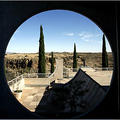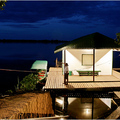This Summer, It’s Rock Around the Bloc

The Exit Festival in Novi Sad, Serbia.
DESPITE recent events hinting at its resuscitation, the Cold War pretty much conked out for good 18 years ago. For music fans in the former Eastern bloc, the demise of the old regime brought about an unexpected benefit: the arrival of rock and techno music festivals on a huge scale previously reserved for May Day celebrations. More recently, Western festivalgoers have begun to take notice of these concerts, drawn not only by the acts, but also by the alluring ticket prices and the unfettered enthusiasm of the audience.
Over the next two months, a half-dozen big concerts will bring international stars to countries that were once locked behind the Iron Curtain, a place where rocking out was a near impossibility, if not outright forbidden. In large part these festivals are considerably cheaper than their Western European equivalents, despite often being much larger: a ticket for the seven-day Sziget Festival in Hungary, for instance, is 37,500 forint ($193 at 195 forint to the dollar), while the Reading festival in England clocks in at three days for £145 ($290 at $2 to the pound). Each show gets you Razorlight, Nine Inch Nails, Gogol Bordello and Unkle, among other groups. But Sziget also includes hundreds of additional performances from the likes of Madness, the Chemical Brothers, Tinariwen, Laurent Garnier and the Good, the Bad and the Queen, as well as lots of local talent.
And there’s an easy-to-overlook bonus: crowds here have loads of enthusiasm and precious little snark.
“Outside of South America, I’d say that people in Eastern Europe are the most joyous crowds to play to,” said Tony McGuinness, one-third of Above & Beyond, the electronic music superpower. “With Poland and the other countries joining the E.U., there’s a great sense of optimism there. Whoever’s on, whatever D.J.’s playing, if it’s good music, they love it.”
Above & Beyond will have to wait until July 7 to feel the love at Creamfields Poland in Wroclaw, where they will perform with the Prodigy, Vitalic and a slew of other dance and electronic acts. But this week, Poland kicks off its festival season on June 29 with Open’er, a three-day party featuring noise-rockers Sonic Youth, neo new-wavers Bloc Party and two sets (one instrumental) from the Beastie Boys, all happening at the Baltic Sea port of Gdynia.
Electronic or rock are hardly the only options: Other concerts around the region this summer include folk, funk, punk and a whole lot of world music — in short, pretty much everything.
I attended my first post-Velvet Revolution music festival in 2005, paying the last-minute equivalent of $20 for a ticket to a concert series in pastoral southern Bohemia, about 90 minutes from Prague. There, joining a group of friends, I relaxed in an old and wrinkled but sturdy Communist-era tent we had taken with us (camping fee: $0) before checking out a six-hour show that began with head-banging Metallica covers from the Finnish cello quartet Apocalyptica and culminated with a barrage of psychotic karate kicks from the moody rocker Nick Cave. Somewhere in the middle were Czech electroclash and punk bands, two immense stages, separate techno and hip-hop tents, hair-styling salons, tattoo and piercing artists and tons of food vendors. More notable, there was a very friendly feel wherever you turned. Unlike the mud of Woodstock, the mosh pits of Lollapalooza and the chaos at Altamont, the scene here was clean, strangely placid and oddly familial. There was plenty of alcohol, but no visible drunkenness, plenty of bouncers but no bouncing, just a bunch of people of all ages having a great time.
A similar ambience can be expected at a much larger Czech festival: Rock for People, July 4 to 7, which takes place near Hradec Kralove, about 70 miles east of Prague. This year’s lineup includes punk and post-punk groups like the Killers, the Hives and the Toy Dolls, as well as world music greats like Mory Kanté, the Guinean master of the kora harp.
There are so many other great festivals around the region that choosing just one seems impossible. Beyond Creamfields and Open’er in Poland, there’s the Pohoda Festival in Slovakia, the very name of which is akin to “cool,” a fitting label for a showcase of Air, Basement Jaxx, DJ Shadow and Cansei de Ser Sexy, among others. Or there is the Exit Fest in Novi Sad, Serbia, with more Beastie Boys and Cansei de Ser Sexy, as well as such disparate musicians as Robert Plant and Snoop Dogg, though presumably not together.
And then there is Sziget in Budapest., on Obudai, an island in the Danube, Aug. 8 to 15. Sziget functions less as a music festival than as a kind of small-scale United Nations, bringing in musicians from Iceland (GusGus) to Cameroon (Manu Dibango) and most places in between: Japan (Gocoo), Finland (Varttina), Russia (Leningrad), France (Sergent Garcia), Mali (Salif Keita) plus dozens of acts from Britain and the United States.
Though the big acts create the headlines, there’s plenty of good stuff on the smaller stages scattered around, according to Erik D’Amato, the American editor of pestiside.hu, an online magazine based in Budapest.
“If you want to see something different, you have to seek out the little tents with different stuff,” Mr. D’Amato said. “There’s always a Roma music tent, and there’s jazz and local bands that just show up and play. And you have to see Kiss Forever, which I would say is the world’s finest Kiss cover band.”
Despite the throngs — Sziget had almost 400,000 visitors last year — Mr. D’Amato says that the festival pulls it off very well.
“The last time I went, you could still get a taxi out at the end of the night,” he said, referring to 2005. “It’s pretty well organized. But if you want to do it right, you should definitely camp there. It isn’t as terrifying as it sounds, assuming that you don’t start on the last few days.”
At that point, he said, the island turns into “a central European version of Max Yasgur’s farm.”
Though today’s festivals are longer, larger and probably much louder, none of them appears likely to ever become the generational touchstone that Woodstock was 40 years ago, in part simply because of the surfeit of options.
As odd as it may sound, there are now almost too many festivals showing too many bands in the former Eastern bloc.
By the Time I Got to Hradec Kralove
Prices are for tickets bought in advance; they may cost more if bought at the site.
Open’er, Gdynia, Poland; www.opener.pl; June 29 to July 1. Acts include Sonic Youth, the Roots, Dizzee Rascal, the Beastie Boys, Muse, Groove Armada, Björk and Bloc Party. Tickets are 249 zloty ($86 at 2.9 zloty to the dollar) for all three days, 269 zloty with camping included.
Rock for People, Hradec Kralove, Czech Republic; www.rockforpeople.com; July 4 to 7. Acts include the Killers, Basement Jaxx, the Hives, Flipsyde, the Toy Dolls and Mory Kanté. Tickets are 740 Czech koruna ($34 at 21.8 koruna to the dollar) for all three days with camping available for an additional 50 koruna.
Creamfields Poland, Wroclaw, Poland; www.creamfields.pl; July 7. Acts include the Prodigy, Above & Beyond, Vitalic and Fisz & Emade. Tickets are 37 euros ($50 at $1.36 to the euro).
Exit Festival, Novi Sad, Serbia; www.exitfest.org; July 12 to 15. Acts include the Beastie Boys, Cansei de Ser Sexy, Lauryn Hill, Robert Plant and Snoop Dogg. Tickets for four days are 78.50 euros ($107 at $1.36 to the euro) with camping an additional 15 euros.
Pohoda Festival, Trencin, Slovakia; www.pohodafestival.sk; July 20 and 21. Acts include Air, the Hives, DJ Shadow, Junkie XL, Tata Bojs and Gipsy.cz. Two-day tickets are 1,199 Slovak koruna ($46 at 26 koruna to the dollar).
Sziget Festival, Budapest, Hungary; www.szigetfestival.com; Aug. 8 to 15. Acts include Razorlight, Chris Cornell, Chemical Brothers, Faithless, Madness, Nine Inch Nails and Pink. Tickets for all seven days are 37,500 forint ($193 at 195 forint to the dollar), including camping, with one-day tickets 7,500 forint.






